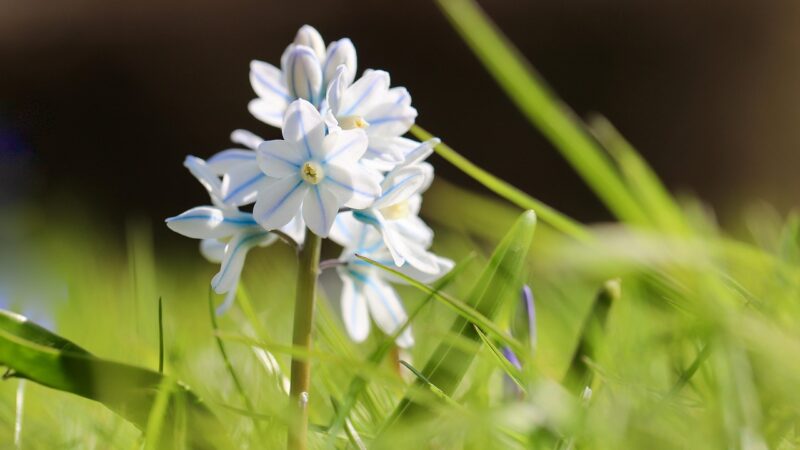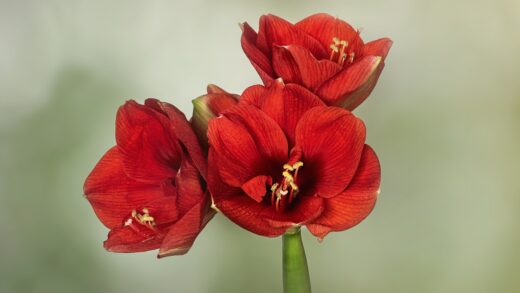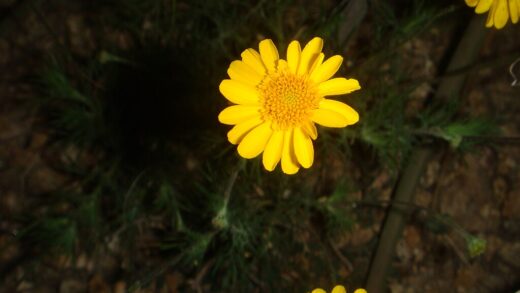The diseases and pests of the striped squill

Striped squill is widely regarded as a resilient and largely trouble-free addition to the garden, demonstrating a notable resistance to many of the common diseases and pests that afflict other ornamental plants. This inherent hardiness makes it an appealing choice for gardeners seeking low-maintenance beauty. However, no plant is completely immune to potential issues, and being aware of the few problems that can occasionally arise is key to maintaining a healthy and flourishing colony. The most significant threats to striped squill are not typically insects or specific pathogens, but rather adverse environmental conditions, particularly those related to soil moisture. Understanding these potential vulnerabilities allows for proactive care and swift intervention if a problem does occur.
The vast majority of issues encountered with striped squill can be traced back to suboptimal growing conditions, with poor drainage being the primary culprit. Excessively wet soil, especially during the bulb’s dormant period in the summer, creates an anaerobic environment that is ideal for the proliferation of fungal and bacterial organisms. These pathogens can lead to bulb rot, which is the most common and serious ailment affecting this plant. Therefore, preventative measures focusing on proper site selection and soil preparation are far more effective than any subsequent treatment.
In terms of pests, striped squill is fortunate to be unpalatable to many of the larger garden marauders, such as deer and rabbits, which tend to leave them alone. However, smaller pests can sometimes cause minor cosmetic damage. Slugs and snails may be attracted to the tender new growth in early spring, and certain soil-dwelling insects or rodents might occasionally disturb the bulbs. For the most part, these pest issues are infrequent and rarely threaten the overall health or survival of the plant colony.
By focusing on creating a healthy growing environment that mimics the plant’s natural habitat, gardeners can almost entirely avoid disease and pest problems. A proactive approach that emphasizes well-draining soil, appropriate planting depth, and good air circulation will result in a robust stand of striped squill that can fend for itself. This focus on prevention over cure is the cornerstone of successful and sustainable cultivation of these delightful spring-flowering bulbs.
Fungal diseases and bulb rot
The most prevalent and damaging issue that can affect striped squill is bulb rot. This is not a single disease but rather a general term for a condition caused by various soil-borne fungi, such as those from the Fusarium or Penicillium genera. These pathogens thrive in soil that is poorly drained and remains waterlogged for extended periods. When the soil is saturated, it lacks the oxygen that the bulb’s roots need to function properly, making the bulb weak and highly susceptible to fungal attack. The fungus invades the bulb tissue, causing it to decay.
More articles on this topic
The symptoms of bulb rot are often first noticed above ground. The plant’s growth may be stunted, the leaves may appear yellowed or wilted despite adequate moisture, and the flowering may be poor or absent altogether. If you were to dig up an affected bulb, you would find it to be soft, mushy, and often discolored, sometimes with a foul odor. In advanced stages, the bulb may have completely disintegrated. Unfortunately, once a bulb has started to rot, it cannot be saved.
Prevention is the only effective strategy against bulb rot. This starts with careful site selection and thorough soil preparation. Choose a planting location where water does not pool, and if you have heavy clay soil, amend it generously with organic matter like compost, leaf mold, or horticultural grit to improve its structure and drainage. Planting on a slight slope or in raised beds can also help to ensure that excess water drains away from the bulbs’ root zone.
It is also important to handle bulbs carefully to avoid bruising or physical damage, as wounds can provide an entry point for fungal pathogens. When purchasing bulbs, inspect them to ensure they are firm and free from any soft spots or signs of mold. If you discover a rotting bulb in an existing clump, it is best to remove and discard it promptly to prevent the fungal spores from spreading through the soil to neighboring healthy bulbs.
Common garden pests
While striped squill is generally pest-resistant, a few common garden inhabitants may occasionally cause minor issues. Slugs and snails are perhaps the most likely culprits, especially during the damp weather of early spring. They are drawn to the tender, emerging foliage and can chew ragged holes in the leaves and sometimes damage the delicate flower petals. While this damage is usually cosmetic and rarely threatens the life of the plant, it can detract from its appearance.
More articles on this topic
Managing slugs and snails can be done through several methods. Creating a barrier of crushed eggshells, diatomaceous earth, or copper tape around the planting area can deter them. Beer traps, set flush with the soil level, are also an effective way to attract and drown these pests. For a more direct approach, hand-picking them from the plants in the evening or on damp mornings, when they are most active, can help to keep their numbers in check.
Another potential pest is the narcissus bulb fly. Although its primary host is the daffodil (Narcissus), it can occasionally lay its eggs near other spring bulbs, including striped squill. The resulting larva, a maggot, burrows into the bulb and feeds on its interior, hollowing it out and killing the plant. A tell-tale sign of an infestation is a bulb that fails to sprout in the spring. If you dig it up and find it soft with a large maggot inside, the narcissus bulb fly is the likely cause. The best prevention is good garden hygiene; promptly remove and destroy any infested bulbs to break the pest’s life cycle.
Aphids can also occasionally be found on the leaves or flower stems, particularly if the plants are stressed. These small, sap-sucking insects can cause distortion of the leaves and excrete a sticky substance called honeydew. In most cases, natural predators like ladybugs and lacewings will keep aphid populations under control. If an infestation becomes heavy, a strong spray of water from a hose can be effective at dislodging them.
Rodent and mammal damage
One of the significant advantages of planting striped squill is that it is generally ignored by larger herbivores like deer and rabbits. These animals typically find the foliage unpalatable and will usually pass them by in favor of more tempting garden fare like tulips or hostas. This resistance makes them an excellent choice for gardens where these animals are a common problem, allowing gardeners to enjoy an early spring display without the need for fences or repellents.
However, smaller mammals, particularly rodents, can sometimes pose a threat. Squirrels and chipmunks are notorious for their digging activities. They may not be interested in eating the bulbs, but in the process of burying their own food stores or searching for previously buried nuts, they can inadvertently dig up and displace newly planted striped squill bulbs. This is most common in the autumn shortly after planting. Laying a piece of chicken wire or mesh over the soil surface after planting, and removing it in early spring before the shoots emerge, can effectively prevent this disturbance.
Voles, which are small, mouse-like rodents that create tunnels underground, can be a more serious problem. Unlike squirrels, voles feed on plant roots and bulbs and can decimate a colony from below without ever being seen. They are particularly active under the cover of snow in the winter. If you notice that a significant portion of your striped squill planting fails to emerge, voles could be the cause.
Controlling voles can be challenging. One effective preventative measure is to plant the bulbs in wire mesh cages. Surrounding the planting area with a barrier of coarse gravel or grit can also deter them, as they dislike tunneling through sharp materials. Encouraging natural predators like hawks, owls, and snakes by maintaining a diverse garden habitat can also help to keep vole populations in balance. Fortunately, significant damage from voles to striped squill is not a widespread issue, but it is a possibility to be aware of in areas with high rodent populations.
Prevention and garden hygiene
The most effective approach to managing diseases and pests in striped squill is through prevention and the practice of good garden hygiene. A healthy, vigorous plant is naturally more resistant to problems than one that is stressed by poor growing conditions. The foundation of this preventative care is ensuring the plants are sited correctly in well-draining soil with appropriate light exposure. This single step will prevent the vast majority of potential issues, particularly the dreaded bulb rot.
Good hygiene practices play a crucial role in minimizing the spread of problems. This includes removing and destroying any plant material that shows signs of disease. If you must dig up a rotting bulb, do not place it in your compost pile, as the fungal spores can survive and be spread back into the garden later. Similarly, at the end of the season, cleaning up the withered foliage after it has completely died back can help to remove any overwintering pest eggs or fungal spores.
When planting new bulbs, always source them from a reputable supplier and inspect them carefully upon arrival. Discard any that are soft, damaged, or show signs of mold. Spacing the bulbs properly during planting also contributes to their health. Good spacing ensures adequate air circulation around the foliage as it grows, which allows it to dry more quickly after rain and reduces the likelihood of fungal leaf diseases, although these are rare on striped squill.
Finally, promoting biodiversity in your garden is a powerful, long-term strategy for pest management. By planting a variety of flowering plants, you can attract beneficial insects like ladybugs, lacewings, and hoverflies, which are natural predators of pests like aphids. A healthy garden ecosystem tends to keep pest populations in a natural balance, reducing the need for direct intervention. This holistic approach creates a resilient garden where plants like striped squill can thrive with minimal fuss.



















